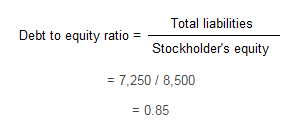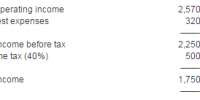Debt to equity ratio can be a long term solvency percentage that indicates the particular soundness of long-term financial policies with the company. It shows the relation involving the portion of assets provided by the the stockholders and the portion of assets provided by creditors. It can be calculated by splitting total liabilities by means of stockholder’s equity.
Debt to equity ratio is also known as “external-internal equity ratio”.
Formula

The numerator consists of the total of current and long term liabilities and the denominator consists of the total stockholders’ equity including preferred stock.
Example:
XYZ company has applied for a loan. The lender of the loan requests a person to compute the debt to equity ratio as a part of the long-term solvency test of the company.
The “Liabilities and Stockholders Equity” section of the balance sheet of XYZ company is given below:

Required: Compute debt to equity ratio of XYZ company.
Solution:

The debt to equity ratio of ABC company is 0.85 or 0.85 : 1. It means the creditors of XYZ company provide 85 cents of assets for each $ 1 of assets provided by stockholders.













